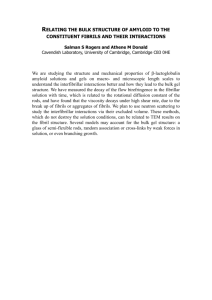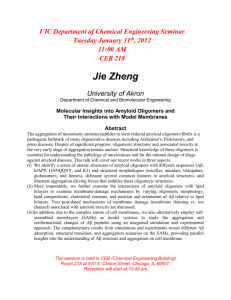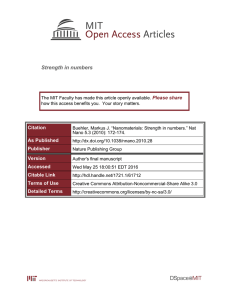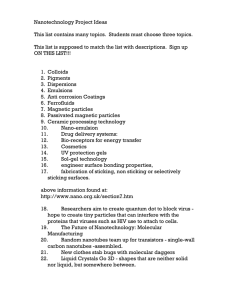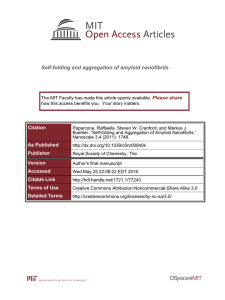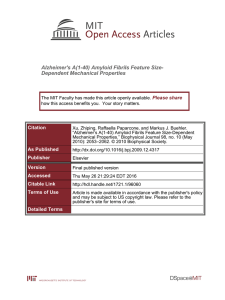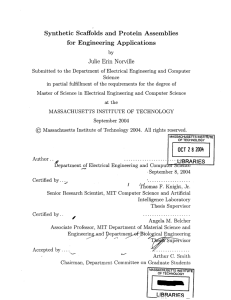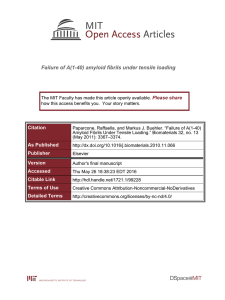Self-Organizing Bio
advertisement
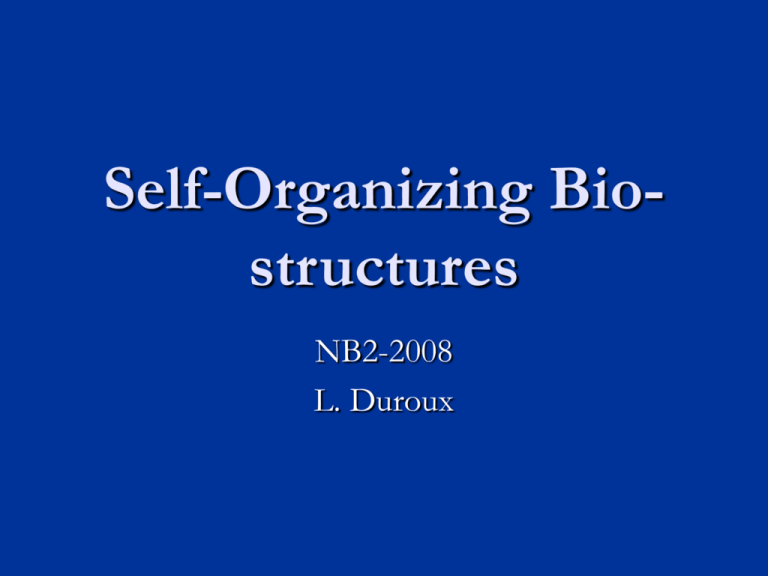
Self-Organizing Biostructures NB2-2008 L. Duroux Lecture 7 Protein-based nanomaterials 1. Peptide-based nanostructures A first insight into SA peptides Concept of peptide SA introduced by Ghadiri et al. (1993) Synthetic cyclic polypeptides (alternate L- & D-) self-assemble into Ø8-9nm nanotubes Function as novel antimicrobial agents, drug delivery systems & nanomaterials Ghadiri’s cyclic polypeptides (CPP) Electronic microscopy pH-dependance of CP SA CPP forming pores in membranes Self-Assembling Peptide Nanotubes cyclic-peptides self-assembled into open tubes consist of an even number of alternated D / L amino acids formation of anti-parallel hydrogen bonded network assembly could be controlled by electrostatic interactions assembly could be directed toward particular environments (hydrophobic) by selection of amino acids are functional material (ion channel & antibiotic) SA based on native ndary 2 structural motifs Protein structural motifs & SA designs Amyloid fibrils Type II polyPro helix SA Fibers engineering based on coiledcoils Woolfson & Ryadnov, 2006 Amyloid peptides A generic, universal form of protein/peptide aggregation Cause of many diseases: Altzheimer’s, Type II diabetes, Prions... Extended b-sheet SA forming fibrils Nano-object formed by amyloid peptides Object formed Amyloid fibrils (pancreas type II diabetes) Amyloid fibrils Nanotubes Nanospheres The role of aromatics in amyloid fibrils formation Phe dipeptide: the recognition core of Altzheimer’s amyloid fibril Forms nanotubes Applications in nano-electronics SA based on amphiphilicity Structures of peptides used in SA Boloamphiphile Amphiphile Surfactant-like Phenylalanine dipeptide Reches and Gazit, 2006 Peptide nanotubes Applications Nanotubes with Ca-binding and cell-adhesion bone-like material Idem, non-conjugated Nanofibers forming hydrogel matrix for tissue regeneration & engineering Peptide-Amphiphile and Tissue Engineering SA fibers with CCCCGGGS(PO4)PGD: without Ca2+ (a) and Ca2+ (b) Aromatic dipeptides Hydrophobic layers made with dipeptides Görbitz, 2006 Types of nanostructures from various dipeptides SA of Val-Ala class SA patterns of the Phe-Phe class Phe-Trp Phe-Gly Phe-Leu Phe-Phe Formation of nanotubes with PhePhe dipeptides 2. Protein-based SA nanotools S-layer proteins What are S-Layer proteins? S stands for surface: glycoprotein subunits forming outer envelope of Bacteria and Archea Periodic structures with defined physico-chemical properties (pore size) Self_assemble into 2D layers to form monomolecular lattices: potential in nanobiotechnologies (scaffolds, patterning matrices) Applications of S-layers 1. 2. 3. 4. 5. 6. production of isoporous ultrafiltration membranes supporting structures for defined immobilization or incorporation of functional molecules (e.g. antigens, antibodies, ligands, enzymes) matrix for the development of biosensors including solid-phase immunoassays and label-free detection systems Support and stabilizing matrices for functional lipid membranes, liposomes, and emulsomes adjuvants for weakly immunogenic antigens and haptens Matrix for controlled biomineralization and structure for formation of ordered arrays of metal clusters or nanoparticles (molecular electronics and nonlinear optics or catalysts) S-Layer lattices 100nm Gram+ bacterium Self-Assembled monomolecular layers S-layer as template for PSA detection Assembly of lipids on S-layers Non-covalent bonding Electrostatic interactions between corrugated (inner) side of S-layer (carboxy groups) and charges on lipid head groups (zwitterions) 2-3 contact points between protein and lipid: most lipids free to diffuse laterally: semi-rigid membrane S-layers as support for lipid membranes Self-Assembly of a ion-channel in S-layers Expected applications of S-layerdriven SA of lipid membranes Life Sciences: Drug delivery Diagnostics Biosensors Chemistry and material sciences Bio-mineralization Non-linear optics Molecular electronics Catalysis
